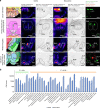Activating an anterior nucleus gigantocellularis subpopulation triggers emergence from pharmacologically-induced coma in rodents
- PMID: 31263107
- PMCID: PMC6603023
- DOI: 10.1038/s41467-019-10797-7
Activating an anterior nucleus gigantocellularis subpopulation triggers emergence from pharmacologically-induced coma in rodents
Abstract
Multiple areas within the reticular activating system (RAS) can hasten awakening from sleep or light planes of anesthesia. However, stimulation in individual sites has shown limited recovery from deep global suppression of brain activity, such as coma. Here we identify a subset of RAS neurons within the anterior portion of nucleus gigantocellularis (aNGC) capable of producing a high degree of awakening represented by a broad high frequency cortical reactivation associated with organized movements and behavioral reactivity to the environment from two different models of deep pharmacologically-induced coma (PIC): isoflurane (1.25%-1.5%) and induced hypoglycemic coma. Activating aNGC neurons triggered awakening by recruiting cholinergic, noradrenergic, and glutamatergic arousal pathways. In summary, we identify an evolutionarily conserved population of RAS neurons, which broadly restore cerebral cortical activation and motor behavior in rodents through the coordinated activation of multiple arousal-promoting circuits.
Conflict of interest statement
The authors declare no competing interests.
Figures





Similar articles
-
Serotonergic neurons in the dorsal raphe nucleus mediate the arousal-promoting effect of orexin during isoflurane anesthesia in male rats.Neuropeptides. 2019 Jun;75:25-33. doi: 10.1016/j.npep.2019.03.004. Epub 2019 Mar 20. Neuropeptides. 2019. PMID: 30935682
-
Physostigmine and Methylphenidate Induce Distinct Arousal States During Isoflurane General Anesthesia in Rats.Anesth Analg. 2016 Nov;123(5):1210-1219. doi: 10.1213/ANE.0000000000001234. Anesth Analg. 2016. PMID: 26991753 Free PMC article.
-
Activation of Preoptic Tachykinin 1 Neurons Promotes Wakefulness over Sleep and Volatile Anesthetic-Induced Unconsciousness.Curr Biol. 2021 Jan 25;31(2):394-405.e4. doi: 10.1016/j.cub.2020.10.050. Epub 2020 Nov 13. Curr Biol. 2021. PMID: 33188746 Free PMC article.
-
[Selective stimulations and lesions of the rat brain nuclei as the models for research of the human sleep pathology mechanisms].Glas Srp Akad Nauka Med. 2011;(51):85-97. Glas Srp Akad Nauka Med. 2011. PMID: 22165729 Review. Serbian.
-
Objective and graded calibration of recovery of consciousness in experimental models.Curr Opin Neurol. 2021 Feb 1;34(1):142-149. doi: 10.1097/WCO.0000000000000895. Curr Opin Neurol. 2021. PMID: 33278146 Free PMC article. Review.
Cited by
-
General anesthesia globally synchronizes activity selectively in layer 5 cortical pyramidal neurons.Neuron. 2022 Jun 15;110(12):2024-2040.e10. doi: 10.1016/j.neuron.2022.03.032. Epub 2022 Apr 21. Neuron. 2022. PMID: 35452606 Free PMC article.
-
Inactivation of Prefrontal Cortex Delays Emergence From Sevoflurane Anesthesia.Front Syst Neurosci. 2021 Jul 9;15:690717. doi: 10.3389/fnsys.2021.690717. eCollection 2021. Front Syst Neurosci. 2021. PMID: 34305541 Free PMC article.
-
Current and Developing Approaches for Facilitating Emergence from General Anesthesia.Anesthesiology. 2025 Oct 1;143(4):1049-1089. doi: 10.1097/ALN.0000000000005600. Epub 2025 Sep 9. Anesthesiology. 2025. PMID: 40923827 Review.
-
Roles of Motor Cortex Neuron Classes in Reach-Related Modulation for Hemiparkinsonian Rats.Front Neurosci. 2021 Apr 27;15:645849. doi: 10.3389/fnins.2021.645849. eCollection 2021. Front Neurosci. 2021. PMID: 33986639 Free PMC article.
-
Historical and Modern Evidence for the Role of Reward Circuitry in Emergence.Anesthesiology. 2022 Jun 1;136(6):997-1014. doi: 10.1097/ALN.0000000000004148. Anesthesiology. 2022. PMID: 35362070 Free PMC article. Review.
References
Publication types
MeSH terms
Substances
Grants and funding
LinkOut - more resources
Full Text Sources
Medical

